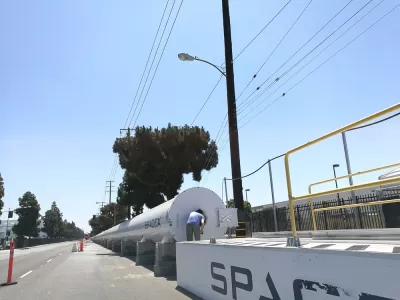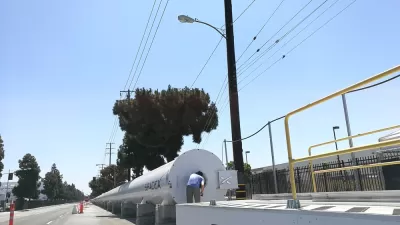A feasibility analysis published today estimates costs and benefits for the still-unproven Hyperloop technology, as envisioned for a route connecting Cleveland and Chicago.

Steven Litt reports the details of a feasibility analysis of a Hyperloop connecting Cleveland to Chicago, published today by the Northeast Ohio Areawide Coordinating Agency (NOACA) and the Los Angeles-based Hyperloop Transportation Technologies.
"A high-speed hyperloop line that could zoom passengers through a vacuum tube from Cleveland to Chicago and Pittsburgh could cost from $24.7 billion to $29.8 billion to build, depending on variations in the route and stops along the way," explains Litt of the findings included in the feasibility analysis.
NOACA Executive Director Grace Gallucci is quoted extensively in the article explaining that the impetus for the study and the project is coming from the private sector, which would be expected to pay most of the costs of any project.
"NOACA’s not trying to push this," says Gallucci in the article. "NOACA wants to be part of the innovation and a leader, but that’s very different from pushing it. This is not our agenda."
The article includes details on how the technology is expected to work, along with data on the jobs and economic benefit the project's construction could deliver to the region's along the Cleveland to Chicago route.
FULL STORY: Cleveland hyperloop benefits would justify $29.8 billion price tag: study

Study: Maui’s Plan to Convert Vacation Rentals to Long-Term Housing Could Cause Nearly $1 Billion Economic Loss
The plan would reduce visitor accommodation by 25% resulting in 1,900 jobs lost.

Alabama: Trump Terminates Settlements for Black Communities Harmed By Raw Sewage
Trump deemed the landmark civil rights agreement “illegal DEI and environmental justice policy.”

Why Should We Subsidize Public Transportation?
Many public transit agencies face financial stress due to rising costs, declining fare revenue, and declining subsidies. Transit advocates must provide a strong business case for increasing public transit funding.

Paris Bike Boom Leads to Steep Drop in Air Pollution
The French city’s air quality has improved dramatically in the past 20 years, coinciding with a growth in cycling.

Why Housing Costs More to Build in California Than in Texas
Hard costs like labor and materials combined with ‘soft’ costs such as permitting make building in the San Francisco Bay Area almost three times as costly as in Texas cities.

San Diego County Sees a Rise in Urban Coyotes
San Diego County experiences a rise in urban coyotes, as sightings become prevalent throughout its urban neighbourhoods and surrounding areas.
Urban Design for Planners 1: Software Tools
This six-course series explores essential urban design concepts using open source software and equips planners with the tools they need to participate fully in the urban design process.
Planning for Universal Design
Learn the tools for implementing Universal Design in planning regulations.
Smith Gee Studio
Alamo Area Metropolitan Planning Organization
City of Santa Clarita
Institute for Housing and Urban Development Studies (IHS)
City of Grandview
Harvard GSD Executive Education
Toledo-Lucas County Plan Commissions
Salt Lake City
NYU Wagner Graduate School of Public Service




























